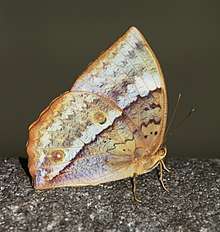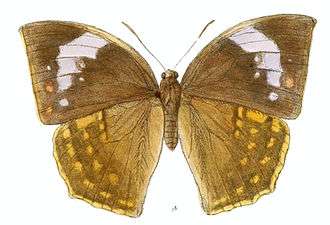Discophora lepida
Discophora lepida, the southern duffer,[1][2] is a butterfly found in Sri Lanka and south India that belongs to the duffers group, that is, the Morphinae subfamily of the brush-footed butterflies family.[2][1]
| Southern duffer | |
|---|---|
 | |
 | |
| Scientific classification | |
| Kingdom: | |
| Phylum: | |
| Class: | |
| Order: | |
| Family: | |
| Genus: | |
| Species: | D. lepida |
| Binomial name | |
| Discophora lepida (Moore, 1857) | |
Description
This species resembles Discophora celinde, but in the male the ground colour on the upperside is dark velvety brown without any blue reflections; the forewing is crossed pre-apically by three obliquely-placed, comparatively large, pale-blue spots with an ill-defined series of three or four much smaller subterminal spots; in the female the markings, though similar to those in the female of D. celinde, are on the upperside of the forewing all pale blue, not yellow, and more numerous, larger, and better defined on the upperside of the hindwing. Underside. Male similar to that in male of D. celinde, but a more or less prominent diffuse subterminal band irrorated with lilac scales crosses both forewing and hindwing. Female similar to the female of D. celinde, but much paler.[3][4] Wingspan 80–104 mm.
Distribution
It is found in South India and Sri Lanka.[2][1]
Status
In 1957, Mark Alexander Wynter-Blyth described the species as rare.[5][6]
Life cycle
Larva
"Cylindrical or slightly fusiform; bead large; anal segment furnished with two stout conical processes widely separated, but scarcely divergent; colour of head greenish yellow; eyes black; body brown, with a broad pure white dorsal band flanked with conspicuous black marks, and a yellow lateral mark on segments 6 to 11; head and body clothed with long reddish or brown hair." (Davidson, Bell and Aitken)[3]
Pupa
"... head-case produced into two long conical adjoined processes, the thorax slightly convex and carinated dorsally, the wing-cases evenly expanded, abdomen strongly curved dorsally; surface finely rugose; colour semi-transparent yellowish, like a clean white bone, with the dorsal line anc the veins of: the wings marked in faint flesh-colour, loosely attached by the tail."[3]
References
- R.K., Varshney; Smetacek, Peter (2015). A Synoptic Catalogue of the Butterflies of India. New Delhi: Butterfly Research Centre, Bhimtal & Indinov Publishing, New Delhi. p. 160. doi:10.13140/RG.2.1.3966.2164. ISBN 978-81-929826-4-9.
- "Discophora Boisduval, [1836]" at Markku Savela's Lepidoptera and Some Other Life Forms
-

-

- Wynter-Blyth, Mark Alexander (1957). Butterflies of the Indian Region. Bombay, India: Bombay Natural History Society. p. 136. ISBN 978-8170192329.
- Gaonkar, Harish (1996). Butterflies of the Western Ghats, India (including Sri Lanka) - A Biodiversity Assessment of a Threatened Mountain System. Bangalore, India: Centre for Ecological Sciences. p. Table I.5.